

Wilmington is a city of 55,530 on the Cape Fear River near the coast in southeastern North Carolina. Its deep water port, one of the busiest between Baltimore and Savannah, is a major factor that helps the city and New Hanover County weather cyclical changes in the economy. The Consolidated Plan was drafted on the assumption that Wilmington's prospects for continued growth will be in direct proportion to its ability to reduce negative economic effects on its at-risk population.
Wilmington's Planning and Development Department has compiled, and the city council has approved, a Consolidated Plan outlining strategies for providing affordable housing, a suitable living environment, and economic development that will generate jobs and revenue. It includes a 5-year strategy for carrying out community and economic development and a 1-year action plan. The city is entitled to $917,000 in Community Development Block Grant (CDBG) funds and $518,000 in HOME funds in 1995, and anticipates $69,700 in program income. With required matching HOME funds of $64,750, a total of $1,569,450 will be available for the 1995-96 program year.
To increase participation by city residents in developing the Consolidated Plan, notices were sent to such organizations as neighborhood associations, churches, organizations representing public housing residents, economic development groups, and the Wilmington Community Coalition's Board of Directors. Newspapers and television stations were notified, as were city and county service providers.
City staff sought information and insight from specific issue-oriented agencies and individuals, including Coordinated Services for the Homeless, Wilmington Housing Finance & Development, Wilmington Transit Authority, Police Department, Wilmington Housing Authority, and Council for Children. Organizations such as these were asked to encourage clients to take part in the planning process.
Residents, neighborhood organizations, and housing and economic development professionals attended three workshops, one each on housing, suitable living environment, and economic development. Participants identified priorities, goals, and objectives and strategies for the next 5 years.
Three hearings provided opportunities for public comment. Copies of the proposed plan were available in three public locations and technical assistance was provided to low-income groups requesting clarification of any aspect of the plan.
Wilmington is home to a campus of the University of North Carolina. In recent years the city has attracted an active filmmaking industry. Favorable climate, proximity to Atlantic Ocean beaches, and a sizable historic district combine to make it a magnet for tourists, second-homebuyers, and retirees.
From a population of 44,000 in 1980, Wilmington grew to 55,530 by 1990, and is projected to increase to 62,365 by the year 2000. The average annual increase over the past decade and a half has been 2.62 percent, much of which can be attributed to annexations.
The working-age population (15 to 64) has increased by 28 percent since 1980. This group accounts for two-thirds of the population. Surrounding New Hanover County projects an increased population of retirees and those nearing retirement. Such a maturing of the population would place a greater burden for supporting the tax base on a declining workforce.
Although African Americans make up 34 percent of the Wilmington population, whites (65 percent) predominate. Other ethnic groups represent only 1 percent of the population.

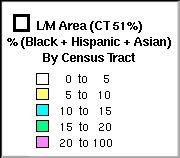
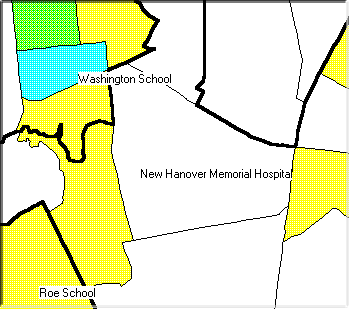
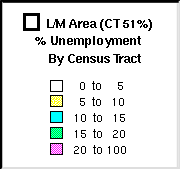
There are 23,557 households in Wilmington. Household size (2.25 persons per household in 1990) has been steadily decreasing since the 1960s, the result of fewer children per family, delayed childbearing, more single-parent families, fewer females of childbearing age, and increasing longevity.
Families (containing at least two people related by blood, marriage, or adoption) account for 59 percent of all households in Wilmington, compared with 71 percent nationally. From 1980 to 1990, nonfamily households (householders living alone or with nonrelated individuals only) increased by 56 percent to 9,654.
Of the 26,469 housing units in the 1990 census, 89 percent were occupied, split almost evenly between owner-occupied and renter-occupied units. Single-family units made up 57 percent of all housing. A third of the city's housing stock was over 40 years old in 1990. In the historic district, structures date to the mid-1800s. Still, many residential areas contain houses built in the early- to mid-1990s.
New Hanover County's median income is $37,600. Low- to moderate-income households account for 60 percent of all households, including 8,188 in the very low-income category (below 50 percent of area median family income), 4,273 classified other low-income (51 to 80 percent of median), and 1,631 moderate-income (81 to 95 percent of median). Twenty-two percent, or 11,780 persons, fall below the poverty threshold of $12,675 for a family of four. Among female-headed households, 44 percent, or 1,835, are below the poverty level.
Overall unemployment rate was 6.2 percent for 1992, but high unemployment exists among women and African-American, Asian, and low-income households and individuals. Joblessness for African Americans is twice that of whites; joblessness for females is almost 1.5 times that of men.
An analysis of housing supply and housing conditions shows that the needs of the following groups are not being adequately met:
Census information shows that one-third of all households have some kind of housing problem, most often among the very low-income. HUD estimates that 66 percent of the families in New Hanover County cannot afford to purchase a home. The incidence of overcrowding for large-family renter households is 27 percent. This increases to 45 percent for large-family renters in the very low-income category.
The average price for a typical new, conventionally built, single-family home in the county was $105,000 in 1991. The cost of construction and supplies has risen 15 percent to 30 percent over the past 3 years. Yet families with below-median income can afford to pay no more than $70,000 for a house. Overall, the average sales price of a house now is $118,000.
Rents have increased throughout the city as the demand for housing exceeds supply. A December 1994 survey showed rents ranging from $430 to $645, with increases ranging from 4.1 percent to 5.8 percent over 1993. These rents are affordable for families earning more than $17,000 a year. In the current market, units remain vacant for less than 30 days.
An estimated 15 houses priced in the affordable range were built in the city during 1994. Two nonprofit housing sponsors added a total of 67 units to the supply of multifamily, affordable housing in 1994-95.
A 1990 survey in selected inner-city and older neighborhoods found 1,000 lots vacant. However, builders have not made extensive use of these for a range of reasons, including difficulties in acquiring such lots. Building on those lots often is not profitable.
The survey found one in three houses substandard, compared to about 10 percent citywide. The average repair cost for substandard houses is $42 per square foot.
A single-night survey conducted by Coordinated Services for the Homeless (CSH) on February 22, 1995, found a total of 223 homeless persons in the city, the largest numbers of which were families with children. Approximately 88 percent of these were sheltered. The survey found 26 families with children who were not sheltered.
The survey validates a need, identified in the 1990 CHAS, that assistance should be directed to homelessness in families with children. Also needed are transitional housing facilities and additional nighttime emergency shelters for those who do not qualify for admittance to existing shelters (alcoholics, drug addicts, the mentally ill, and the potentially dangerous).
Imbalances between the cost of housing for owners and the cost for renters is a major factor in the risk of homelessness among low- and moderate-income renters. Among owners, 13 percent of those making less than $20,000 pay more than 30 percent toward housing. Among low- to moderate-income renters, that proportion jumps to 41 percent. The ratio is virtually unchanged among those making less than $35,000; only 13 percent of owners exceed the 30-percent cost burden standard while 42 percent of renters do. These figures reveal the need for affordable housing both for rent and for purchase.
The Wilmington Housing Authority, which administers 666 public housing units, has an average waiting list of 1,400. If the families on the waiting list are similar to current assisted housing residents, their incomes are very low. Average income of Section 8 recipients is $5,400 and that of public housing residents is $6,800. Families living in assisted housing are predominately headed by women (93 percent) and 41 percent are elderly. Typically, these families can afford rent ranging only from $58 to $133 per month.
The city recognizes that development standards, particularly those applied to structures in the Historic District, may contribute to the short supply of affordable housing. Design and construction standards interpreted by the Historic District Commission can affect rehabilitation costs and property values. If a pending proposal to expand the historic district is approved, a certificate of appropriateness will be required for alterations within the area. Historic preservationists have raised funds to assist eligible low- and moderate-income homeowners in the proposed expansion area in restoring historic elements of their properties.
In 1993 the city and county jointly adopted a land-use plan that supports policies aimed at expanding mixed-income housing, affordable housing, and jobs and business ventures while protecting and supporting historic and natural resources.
Renovation of older homes has been a significant source of affordable housing in many cities. Observers of mortgage underwriting procedures in Wilmington, however, suggest that hassles involved in buying a house needing repair deter potential buyers. Nevertheless, efforts by the city and Wilmington Housing Finance have enabled 20 households to become first-time homebuyers. Assistance to those buyers was provided through below-market interest rates, reduced downpayment requirements, and leasing to purchase. Even with such programs as these, access to credit remains an obstacle to expanding homeownership.
The Human Relations Commission of New Hanover County implements the Fair Housing Law in Wilmington. This Commission is responsible for consumer and provider education, investigation and enforcement, and landlord-tenant disputes. During the next year, the city will identify and analyze any impediments to fair housing and, if necessary, work with the county staff to design an updated plan.
The Wilmington Housing Authority carries out abatement of lead-based paint as funding permits. Until abatement is completed, the Health Department will notify the Authority of children found to have lead in their blood during normal screening. The Housing Authority tracks the children and takes actions commensurate with the level of lead in their blood. This may involve abating, or reducing, the lead-based paint hazards in the units they occupy or relocating the family.
Wilmington needs to make a more aggressive effort to influence the direction of changes in demographic and employment patterns to achieve a more suitable living environment. Increased college populations at Cape Fear Community College and the University of North Carolina, a growing elderly population, increased business enterprise, and plans for future development of industrial parks substantiate the need to expand the public transit system or alternative transportation.
To lower crime rates, the city will examine such measures as community watches, more activities for youth, and better street lighting. Because crime is more prevalent in areas of higher density, the city will review housing development policies that have an impact on density.
Jobs in Wilmington have increased in the service and retail sectors, but these jobs tend to provide low wages and contribute less to the tax base. Construction employment in New Hanover County increased by 13 percent; manufacturing jobs declined 7 percent.
Stimulus in manufacturing and technical sectors would be most beneficial. The city needs training and education programs and support services that would enable its labor force to fill entry-level jobs and positions requiring higher skills. Jobs and businesses must be located in the inner city to support revitalization there.
Wilmington has adopted the following overall goal:
Provide a range of decent and affordable housing opportunities throughout the city for very low-, low-, and moderate-income households; for homeless individuals and families; for those at risk of being homeless; for special needs populations; and for persons with health problems (such as HIV/AIDS).
Wilmington has set the following long-term housing objectives:
Housing priorities for the 5-year strategy include the following:
CDBG target area neighborhoods are described by both 1995 Consolidated Plan participants and 1994 Enterprise Community residents as magnets for crime, substance abuse, and loitering. Asked how to solve these problems, these participants suggested expanding opportunities for youth and increasing police protection. These residents also emphasized the lack of convenient, accessible shopping. Lack of public transportation makes it difficult for families without automobiles to purchase groceries in other neighborhoods, where selection and prices tend to be better.
To enhance the living environment of these neighborhoods, the consolidated plan calls for revitalized commercial areas, neighborhood resource centers, infrastructure repairs, and streetscape improvements. Other proposals call for community gardens, passive and active recreational spaces as a means of reducing density, and revitalizing neighborhoods.
Measures designed to reduce the incidence of crime in target neighborhoods include community policing, youth enrichment and educational development, job training, and recreational activities.
Efforts to improve neighborhood human services include decreasing density; providing better access to jobs, services, and health care; and alternative communications networks for older citizens, some of whom lack adequate transportation and telephones.
Economic development activities will extend beyond the target areas to include Wilmington's downtown area. Efforts will be made to:
The city, the Housing Authority, and human service agencies are working together to help public housing tenants make the transition into the private housing market. Coordinated services include job readiness training, job placement, and day care. After 5 years the participating households will move into independent living. A similar strategy is being used to promote homeownership among qualified residents of assisted housing.
Coordinated Services for the Homeless is aimed at developing stability in the living situations of homeless persons through counseling, training, job placement, and housing. Some 25 agencies contribute food, shelter, and services for this program. Eight participants have gained stable jobs and are leading independent lives in conventional housing.
The city will continue to encourage participation of neighborhood organizations, nonprofits, and church groups in carrying out the strategic plan. The city has two approved community housing and development organizations and is considering certification of another.
Three coalitions are the structure for coordinated action to carry out the Consolidated Plan:
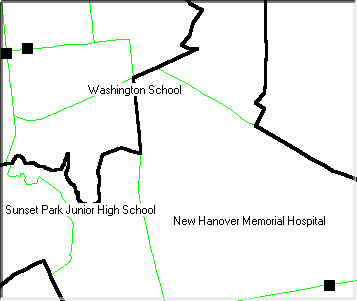
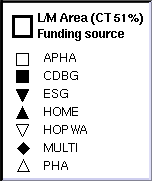
Through CDBG the city will lend more than $300,000 to rehabilitate houses owned and occupied by low- and moderate-income families. Of this, $36,500 is from 1995-1996 CDBG funds, $190,000 is from unspent prior-year balances, and $175,000 is from projected program income in a revolving loan fund. The city will also use $50,000 to institute a lead-based paint abatement program and $109,000 for a housing activity to be determined later.
Wilmington is budgeting $136,000 for economic development this year. These funds will be used to stimulate business and industrial development, job creation, and commercial revitalization.
To address homeownership and neighborhood revitalization and stabilization, the city will lend $250,000 to purchase and rehabilitate houses in target neighborhoods. Of this amount, $200,000 is from the 1995-96 CDBG and HOME funds and $50,000 is from unspent balances. Under the HOME program, funds restricted for use by Community Housing Development Organizations will be used for single-family homeownership for first-time buyers in the inner city.
Public service agencies will receive $132,440.